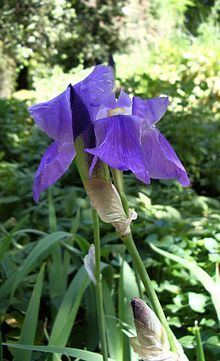Kingdom Plantae Family Iridaceae Tribe Irideae Rank Species | Order Asparagales Subfamily Iridoideae Genus Iris | |
 | ||
People also search for Iris adriatica, Iris psammocola | ||
Iris pseudopallida ('Southern Adriatic iris') is a species in the genus Iris, it is also in the subgenus of Iris. It is a rhizomatous perennial from Croatia. It has flat, curved of sickle-shaped leaves, tall slender stems, 3-8 fragrant flowers, in shades of violet, or pale violet flowers, mauve, lavender, purple, yellow or white, between May and June. The iris was originally thought to be a separate species, but later classified as subspecies of Iris pallida, known as Iris pallida subsp. pseudopallida, although in Croatia, it is still known as Iris pseudopallida. It is cultivated as an ornamental plant in temperate regions, especially in the Balkan regions.
Contents
Description
It has a bluish coloured rhizome, and has flat, curved, or sickle-shaped leaves. The leaves can grow up to 35 cm (14 in) long, and up to 3 cm wide. They can survive the winter. It has a slender stem or peduncles, that can grow up to between 60–100 cm (24–39 in) tall. It has branches (or pedicels) near top of the plant. The stem has (scarious) membranous, (or translucent) spathes (leaves of the flower bud). Similar to Iris illyrica, the spathes can have a dirty, rusty markings. The stems (and the branches) hold between 3 and 8 flowers, between May and June. The fragrant flowers, come in shades of violet, or pale violet flowers, mauve, lavender, purple, yellow or white. Like other irises, it has 2 pairs of petals, 3 large sepals (outer petals), known as the 'falls' and 3 inner, smaller petals (or tepals), known as the 'standards'. The falls are bent backwards, they have a light brown edge and reddish purple veins. They also have a thick strip of yellow hairs (the 'beard') in the centre. The flowers has dry, spheroidal pollen, that are 51-100 µm large. After the iris has flowered, it produces a seed capsule, that has 5 mm long seeds.
Biochemistry
In 2001, a karyologic study was carried out on various irises in the Alpine-Dinaric region (relating to the Dinaric Alps mountain chain), which included Iris cengialti, Iris illyrica, Iris pseudopallida and Iris pallida. It found that the mitotic number of chromosomes of most species was 2n=24.
In 2003, a study was carried out on flavonoids within the leaves of Iris illyrica Tomm. and Iris pseudopallida Trinajstić. It found significant quantitative differences in the leaf flavonoid patterns were obtained.
In 2008, a study was carried out on five iris species including; Iris halophila, Iris pumila, Iris pseudopallida, Iris reichenbachii and Iris sibirica. It investigated vegetative propagation (including in vitro) and secondary metabolite production.
In 2009, a plant regeneration study was carried out on three iris related to Iris pallida, including Iris pseudopallida, Iris illyrica and Iris reichenbachii, all from the Southern Europe. It used somatic embryogenesis.
As most irises are diploid, having two sets of chromosomes, this can be used to identify hybrids and classification of groupings. It has a chromosome count: 2n=24, (published by Mitić, B. 1991. Karioloska analiza nekih populacija vrsta Iris pallida, I. illyrica i I. pseudopallida (Iridaceae). in Acta Bot. Croat. 50: 91–98). Also confirmed in 2001.
Taxonomy
It is commonly known as 'Southern Adriatic iris', It is also known in Croatia, as 'jadranska perunika' meaning Adriatic Iris. The Latin specific epithet pseudopallida refers to 'false', 'pallida' or pale iris.
It was first collected by Ivo Trinajstić on 1 May 1973, and then it was first published and described in 'Biosistematika' (Journal) Vol.2 (Issue 1) on page 71 in 1976. Trinajstić had called the plant, a separate species to Iris pallida, due to the difference in spathes. Iris pallida has silvery white spathes while Iris illyrica and Iris pseudopallida have spathes that have a dirty pale rusty tint. Also in 1991, Nikolic & Mitic found that the size and shape of epidermal cells and stoma, was another difference between the 2 species, but these could be down to habitat effects.
It was also thought to be related to Iris reichenbachii, but a study on Iris orjenii found various differences. Often plants are called one name and are later changed due to a new study.
Later, some authors have re-classified the species as a subspecies of Iris pallida, as Iris pallida subsp. pseudopallida. Although, in Croatia, it is still known as Iris pseudopallida.
It has not yet been verified by United States Department of Agriculture and the Agricultural Research Service as of 20 November 2015.
It is listed in the Encyclopedia of Life.
It is an 'unresolved' name in the The Plant List.
Distribution and habitat
It is native to Southern Europe.
Range
It is found along the Adriatic Coast, of the Balkan Peninsula. In parts the former region of Yugoslavia, now Montenegro, Herzegovina, in Croatia, (including south Dalmatia,) and also in Albania.
It is normally found in Croatia along with Iris reichenbachii, another endemic iris.
Habitat
It grows on rocks (made of limestone or karst), dry meadows or pastures.
They can be found at an altitude above 600 m (2,000 ft), above sea level.
Conservation
It has large colonies of plants, but they may be under risk from collection.
Cultivation
The plants are grown in gardens in Croatia and surrounding countries, and are also available for cultivation elsewhere, used in garden borders.
It can be found in the Biokovo Botanical Garden Kotišina.
Propagation
Irises can generally be propagated by division, or by seed growing.
Toxicity
Like many other irises, most parts of the plant are poisonous (rhizome and leaves), if mistakenly ingested can cause stomach pains and vomiting. Also handling the plant may cause a skin irritation or an allergic reaction.
